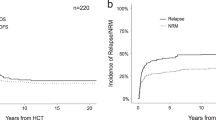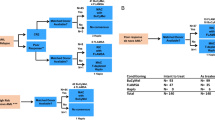Abstract
Despite more than 40 years of extensive study, it remains uncertain which individuals, if any, with acute myelogenous leukemia (AML) in first remission should receive a blood cell or bone marrow transplant versus post-remission chemotherapy (or both). Nevertheless, there is a recent trend toward recommending more transplants in this setting. We consider four myths underlying this recommendation: (1) only individuals achieving second remission benefit from a transplant; (2) there is no effective therapy for relapse other than an allotransplant; (3) we can accurately predict which individuals with AML in first remission need a transplant; and (4) detection of minimal residual disease in first remission will resolve this controversy. We discuss these misconceptions and suggest approaches to resolve this issue.
This is a preview of subscription content, access via your institution
Access options
Subscribe to this journal
Receive 12 print issues and online access
$259.00 per year
only $21.58 per issue
Buy this article
- Purchase on Springer Link
- Instant access to full article PDF
Prices may be subject to local taxes which are calculated during checkout
Similar content being viewed by others
References
Koreth J, Schlenk R, Kopecy KJ, Honda S, Sierra J, Djulbegovic BJ et al. Allogeneic stem cell transplantation for acute myeloid leukemia in first remission: systematic review and meta-analysis of prospective clinical trials. J Am Med Ass 2009; 301: 2349–2361.
Gale RP, Eapen M, Logan B, Zhang MJ, Lazarus H . Comparing therapy-options: are there roles for observational databases and structured quantification of expert opinion to answer therapy controversies in transplants? Bone Marrow Transplant 2009; 43: 435–446.
Cornell JE, Mulrow CD, Localio R, Stack CB, Meibohm AR, Guallar E . Random-effects meta-analysis of inconsistent effects: a time for change. Ann Intern Med 2014; 160: 267–270.
Schlenk RF, Döhner K, Krauter J, Fröhling S, Corbacioglu A, Bullinger L et al. Mutations and treatment outcome in cytogenetically normal acute myeloid leukemia. N Engl J Med 2008; 358: 1909–1918.
Gale RE, Hills R, Kottaridis PD, Srirangan S, Wheatley K, Burnett AK et al. No evidence that FLT3 status should be considered as an indicator for transplantation in acute myeloid leukemia (AML): an analysis of 1135 patients, excluding acute promyelocytic leukemia from the UK MRC AML10 and 12 trials. Blood 2005; 106: 3658–3665.
Forman SJ, Rowe JM . The myth of the second remission of acute leukemia in the adult. Blood 2013; 121: 1077–1082.
Gooley TA, Chien JW, Pergam SA, Hingorani S, Sorror ML, Boeckh M et al. Reduced mortality after allogeneic hematopoietic-cell transplantation. N Engl J Med 2010; 363: 2091–2101.
Agency for Healthcare Research and Quality. 2010 National Healthcare Disparities Report, US Department of Health and Human Services. Agency for Healthcare Research and Quality: Rockville, MD, 2011.
Burnett AK, Goldstone A, Hills RK, Milligan D, Prentice A, Yin J et al. Curability of patients with acute myeloid leukemia who did not undergo transplantation in first remission. J Clin Oncol 2013; 31: 1293–1301.
Hernan MA, Hernandez-Diaz S, Robins JM . Randomized trials analyzed as observational studies. Ann Intern Med 2013; 159: 560–562.
Labopin M, Gorin NC, Polge E, Socié G, Gurman G, Gluckman E et al. A prospective registration study to determine feasibility of hematopoietic SCT in adults with acute leukemia: planning, expectations and reality. Bone Marrow Transplant 2014; 49: 376–381.
Schlenk RF, Benner A, Krauter J, Büchner T, Sauerland C, Ehninger G et al. Individual patient data-based meta-analysis of patients aged 16-60 years with core binding factor acute myeloid leukemia: a survey of the German Acute Myeloid Leukemia Intergroup. J Clin Oncol 2004; 22: 3741–3750.
Marcucci G, Mrózek K, Ruppert AS, Maharry K, Kolitz JE, Moore JO et al. Prognostic factors and outcome of core binding factor acute myeloid leukemia patients with t(8;21) differ from those of patients with inv(16): a Cancer and Leukemia Group B study. J Clin Oncol 2005; 23: 5705–5717.
Schlenk RF, Taskesen E, van Norden Y, Krauter J, Ganser A, Bullinger L et al. The value of allogeneic and autologous hematopoietic stem cell transplantation in prognostically favorable acute myeloid leukemia with double mutant CEBPA. Blood 2013; 122: 1576–1582.
Breems DA, Van Putten WL, Hujigens PC, Ossenkoppele GJ, Verhoef GE, Verdonck LF et al. Prognostic index for adult patients with acute myeloid leukemia in first relapse. J Clin Oncol 2005; 23: 1969–1978.
Chevallier P, Labopin M, Turlure P, Prebet T, Pigneux A, Hunault M et al. A new leukemia prognostic scoring system for refractory/relapsed adult acute myelogenous leukaemia patients: a GOELAMS study. Leukemia 2011; 25: 939–944.
Luger SM, Ringdén O, Zhang MJ, Pérez WS, Bishop MR, Bornhauser M et al. Similar outcomes using myeloablative vs reduced-intensity allogeneic transplant preparative regimens for AML or MDS. Bone Marrow Transplant 2012; 47: 203–211.
Walter RB, Othus M, Borthakur G, Ravandi F, Cortes JE, Pierce SA et al. Prediction of early death after induction therapy for newly diagnosed acute myeloid leukemia with pretreatment risk scores: a novel paradigm for treatment assignment. J Clin Oncol 2011; 29: 4417–4423.
Leening MJ, Vedder MM, Witteman JC, Pencian MJ, Steyerberg EW . Net reclassification improvement: computation, interpretation and controversies: a literature review and clinician’s guide. Ann Intern Med 2014; 160: 122–131.
Goldman JM, Gale RP . What does MRD in leukemia really mean? Leukemia 2013; e-pub ahead of print 30 October 2013 doi:10.1038/leu.2013.318.
Terwijn M, van Putten WL, Kelder A, van der Velden VH, Brooimans RA, Pabst T et al. High prognostic impact of flow cytometric minimal residual disease detection in acute myeloid leukemia: data from the HOVON/SAKK AML 42A Study. J Clin Oncol 2013; 31: 3889–3897.
Butturini A, Klein J, Gale RP . Modeling minimal residual disease (MRD) testing. Leuk Res 2002; 27: 293–300.
Ding L, Ley TJ, Larson DE, Miller CA, Koboldt DC, Welch JS et al. Clonal evolution in relapsed acute myeloid leukemia revealed by whole-genome sequencing. Nature 2012; 481: 506–510.
Gale RP, Goldman JM . Treating chronic myeloid leukemia in the era of tyrosine kinase inhibitors. Acta Haematol 2013; 213: 192–195.
Marin D . Patient with chronic myeloid leukemia in complete cytogenetic response: what does it mean, and what does one do next. J Clin Oncol 2013; 52: 9230.
Gale RP, Park RE, Dubois R, Bitran JD, Buzdar A, Hortobagyi G et al. Delphi-consensus panel analysis of appropriateness of high-dose chemotherapy and blood cell or bone marrow autotransplants in women with breast cancer. Clin Transplant 2000; 14: 32–41.
Ritchie DS, Neeson PJ, Khot A, Peinert S, Tai T, Tainton K et al. Persistence and efficacy of second generation CAR T cell against the LeY antigen in acute myeloid leukemia. Mol Ther 2013; 21: 2122–2129.
Pagel JM, Gooley TA, Rajendran J, Fisher DR, Wilson WA, Sandmaier BM et al. Allogeneic hematopoietic cell transplantation after conditioning with 131I-anti-CD45 antibody plus fludarabine and low-dose total body irradiation for elderly patients with advanced acute myeloid leukemia or high-risk myelodysplastic syndrome. Blood 2009; 114: 5444–5453.
Goodyear OC, Dennis M, Jilani NY, Loke J, Siddique S, Ryan G et al. Azacitidine augments expansion of regulatory T cells after allogeneic stem cell transplantation in patients with acute myeloid leukemia (AML). Blood 2012; 119: 3361–3369.
Acknowledgements
RPG acknowledges support from the NIHR Biomedical Research Centre funding scheme. Drs Elisabeth Paietta and Gary Schiller kindly reviewed the typescript.
Author information
Authors and Affiliations
Corresponding author
Ethics declarations
Competing interests
RPG is a part-time employee of Celgene Corp. PHW is a speaker for Celgene Corp., Novartis and Janssen. HML is a consultant to Actinium Pharmaceuticals, Inc. and Pluristem Therapeutics, Inc. and a speaker for Celgene Corp. Dr Charles Schiffer claims he recently heard Galen comment on his remedy.
Rights and permissions
About this article
Cite this article
Gale, R., Wiernik, P. & Lazarus, H. Should persons with acute myeloid leukemia have a transplant in first remission?. Leukemia 28, 1949–1952 (2014). https://doi.org/10.1038/leu.2014.129
Received:
Accepted:
Published:
Issue Date:
DOI: https://doi.org/10.1038/leu.2014.129
This article is cited by
-
Measurable residual disease status and outcome of transplant in acute myeloid leukemia in second complete remission: a study by the acute leukemia working party of the EBMT
Blood Cancer Journal (2021)
-
Allogeneic haemopoietic transplantation for acute myeloid leukaemia in second complete remission: a registry report by the Acute Leukaemia Working Party of the EBMT
Leukemia (2020)
-
Allogeneic Hematopoietic Stem Cell Transplantation for Older Patients With Acute Myeloid Leukemia
Current Treatment Options in Oncology (2018)
-
Precision oncology for acute myeloid leukemia using a knowledge bank approach
Nature Genetics (2017)
-
Treatment, trial participation and survival in adult acute myeloid leukemia: a population-based study in the Netherlands, 1989–2012
Leukemia (2016)



